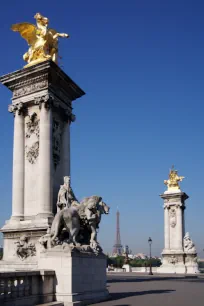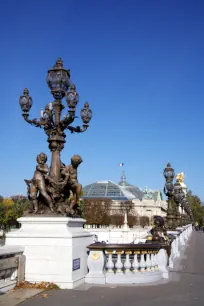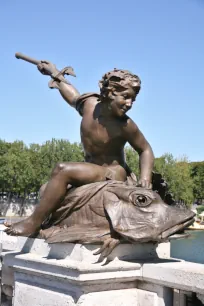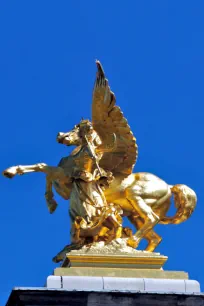Most people consider the nineteenth-century Pont Alexandre III the most beautiful bridge in Paris. It is without a doubt the city’s most opulently decorated bridge.

Orientation
Aligned with the Esplanade des Invalides, the Pont Alexandre III connects the Grand and Petit Palais on the right bank with the Hôtel des Invalides on the left bank.




Construction
The bridge was built at the end of the nineteenth century as part of a series of projects undertaken for the Universal Exposition of 1900. The exposition took place on either side of the Seine River, and the new bridge would enable the millions of visitors to more easily cross the river.
Construction of the bridge, designed by the architect Jean Résal and executed by the engineer Amédée Alby, took almost three years. The structure was first prefabricated in a factory and later transported and assembled by a large crane.
One of the requirements for the bridge was that it should not obstruct the view towards the Invalides and Champs-Élysées. This resulted in a very low 40-meter-wide (132 ft.) bridge with a single 107.5-meter-long (353 ft.) span and a height of only 6 meters (20 ft.).
Ornaments
The bridge is lavishly decorated with lampposts and allegorical sculptures, created by thirteen different sculptors.
On each end of the Pont Alexandre III are large gilded statues perched upon 17-meter-tall (56 ft.) granite pylons. The statues are allegorical representations of Industry, Commerce, Science and the Arts. At the foot of the pylons are seated statues representing different eras in the history of France: France under Charlemagne, France under King Louis XIV, France during the Renaissance, and finally Contemporary France. In front of the pylons are statues of Lions guarding the bridge.
The railings of the bridge are strewn with bronze and copper sculptures. Those around the ornate lampposts depict «Love», while others show genii with fish and shells.
There are yet more sculptures on the side of the bridge. On one side you can see the coat of arms of Paris flanked by nymphs of the River Seine. On the other side is the Russian coat of arms with nymphs of the River Neva.
Tsar Alexander III
Even though construction of the bridge only started in May 1897, the first stone was already laid by the Russian Tsar Nicolas II in October 1896. The bridge – which was to symbolize Russian-French friendship – was named after his father, Tsar Alexander III.
Universal Exposition of 1900
The Pont Alexandre III opened just in time for the Universal Exposition of 1900 together with several structures that still stand today, like the Gare d’Orsay, the Petit Palais and the Grand Palais. The exposition would attract an impressive 50 million visitors.
- Next: Île de la Cité
- More Paris Bridges
- More Sights & Attractions in Paris

